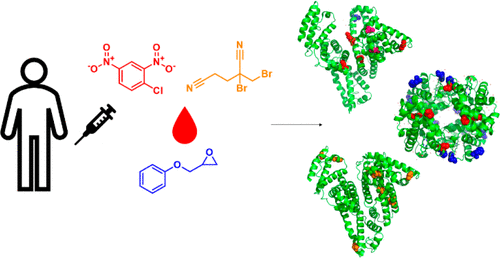当前位置:
X-MOL 学术
›
Chem. Res. Toxicol.
›
论文详情
Our official English website, www.x-mol.net, welcomes your
feedback! (Note: you will need to create a separate account there.)
Characterizing Adduct Formation of Electrophilic Skin Allergens with Human Serum Albumin and Hemoglobin.
Chemical Research in Toxicology ( IF 3.7 ) Pub Date : 2020-09-02 , DOI: 10.1021/acs.chemrestox.0c00271 Lorena Ndreu 1 , Luke N Erber 2, 3 , Margareta Törnqvist 1 , Natalia Y Tretyakova 2, 3 , Isabella Karlsson 1
Chemical Research in Toxicology ( IF 3.7 ) Pub Date : 2020-09-02 , DOI: 10.1021/acs.chemrestox.0c00271 Lorena Ndreu 1 , Luke N Erber 2, 3 , Margareta Törnqvist 1 , Natalia Y Tretyakova 2, 3 , Isabella Karlsson 1
Affiliation

|
Skin (contact) allergy, the most predominant form of immunotoxicity in humans, is caused by small electrophilic compounds (haptens) that modify endogenous proteins. Approximately 20% of the general population in the Western world is affected by contact allergy. Although the importance of the hapten–protein conjugates is well established in the initiation of the immunological reaction, not much progress has been made regarding identification of these conjugates in vivo or exploration of their potential as diagnostic tools. In this study, the human serum albumin (HSA) and human hemoglobin (Hb) adductome for three representative contact allergens with different chemical properties, 1-chloro-2,4-dinitrobenzene (DNCB), 1,2-epoxy-3-phenoxypropane (PGE), and 2-bromo-2-(bromomethyl)glutaronitrile (MDBGN), were studied. Plasma and red blood cell lysate were used as a source for HSA and Hb, respectively. The Direct Peptide Reactivity Assay was used to investigate adduct formation of MDBGN with nucleophilic moieties and revealed that MDGBN is converted to 2-methylenepentanedinitrile in the presence of sulfhydryl groups prior to adduct formation. Following incubation of HSA and Hb with haptens, an Orbitrap Q Exactive high-resolution mass spectrometer was used to perform an initial untargeted analysis to screen for adduct formation, followed by confirmation by targeted Parallel Reaction Monitoring analysis. Although a subset of adducted sites was confirmed by targeted analysis, only some of the adducted peptides showed an increase in the relative amount of the adducted peptide with an increased concentration of hapten. In total, seven adduct sites for HSA and eight for Hb were confirmed for DNCB and PGE. These sites are believed to be the most reactive. Further, three of the HSA sites (Cys34, Cys62, and Lys190) and six of the Hb sites (subunit α: Val1, His45, His72; subunit β: Cys93, His97, and Cys112) were haptenated already at the lowest level of hapten to protein molar ratio (0.1:1), indicating that these sites are the most likely to be modified in vivo. To the best of our knowledge, this is the first time that the adductome of Hb has been studied in the context of contact allergens. Identification of the most reactive sites of abundant proteins, such as HSA and Hb, is the first step toward identification of contact allergy biomarkers that can be used for biomonitoring and to develop better diagnostic tools based on a blood sample.
中文翻译:

表征亲电子皮肤过敏原与人血清白蛋白和血红蛋白的加合物形成。
皮肤(接触)过敏是人类最主要的免疫毒性形式,是由修饰内源性蛋白质的小型亲电子化合物(半抗原)引起的。在西方世界,大约 20% 的普通人群受到接触过敏的影响。尽管半抗原-蛋白质偶联物在免疫反应启动中的重要性已得到充分证实,但在体内鉴定这些偶联物方面并没有取得太大进展或探索它们作为诊断工具的潜力。在本研究中,人血清白蛋白 (HSA) 和人血红蛋白 (Hb) 加合物对于三种具有不同化学性质的代表性接触过敏原,1-氯-2,4-二硝基苯 (DNCB)、1,2-环氧-3-苯氧基丙烷(PGE) 和 2-溴-2-(溴甲基)戊二腈 (MDBGN) 进行了研究。血浆和红细胞裂解物分别用作 HSA 和 Hb 的来源。直接肽反应性测定用于研究 MDBGN 与亲核部分的加合物形成,并揭示 MDBGN 在加合物形成之前在巯基存在的情况下转化为 2-亚甲基戊二腈。HSA 和 Hb 与半抗原孵育后,使用 Orbitrap Q Exactive 高分辨率质谱仪进行初始非靶向分析以筛选加合物形成,然后通过靶向平行反应监测分析进行确认。尽管通过靶向分析证实了加合物位点的子集,但只有一些加合物肽显示出随着半抗原浓度增加,加合物肽的相对量增加。总共确认了 DNCB 和 PGE 的 7 个 HSA 加合物位点和 8 个 Hb 加合物位点。这些站点被认为是最具反应性的。此外,三个 HSA 位点(Cys 只有一些加成肽显示出随着半抗原浓度的增加,加成肽的相对量增加。总共确认了 DNCB 和 PGE 的 7 个 HSA 加合物位点和 8 个 Hb 加合物位点。这些站点被认为是最具反应性的。此外,三个 HSA 位点(Cys 只有一些加成肽显示出随着半抗原浓度的增加,加成肽的相对量增加。总共确认了 DNCB 和 PGE 的 7 个 HSA 加合物位点和 8 个 Hb 加合物位点。这些站点被认为是最具反应性的。此外,三个 HSA 位点(Cys34、Cys 62和 Lys 190)和六个 Hb 位点(亚基 α:Val 1、His 45、His 72;亚基 β:Cys 93、His 97和 Cys 112)已经在半抗原的最低水平上进行了半抗原化与蛋白质的摩尔比 (0.1:1),表明这些位点最有可能在体内被修饰. 据我们所知,这是第一次在接触过敏原的背景下研究 Hb 的加合物。鉴定富含蛋白质(如 HSA 和 Hb)的最具反应性的位点,是鉴定接触过敏生物标志物的第一步,这些生物标志物可用于生物监测和基于血液样本开发更好的诊断工具。
更新日期:2020-10-21
中文翻译:

表征亲电子皮肤过敏原与人血清白蛋白和血红蛋白的加合物形成。
皮肤(接触)过敏是人类最主要的免疫毒性形式,是由修饰内源性蛋白质的小型亲电子化合物(半抗原)引起的。在西方世界,大约 20% 的普通人群受到接触过敏的影响。尽管半抗原-蛋白质偶联物在免疫反应启动中的重要性已得到充分证实,但在体内鉴定这些偶联物方面并没有取得太大进展或探索它们作为诊断工具的潜力。在本研究中,人血清白蛋白 (HSA) 和人血红蛋白 (Hb) 加合物对于三种具有不同化学性质的代表性接触过敏原,1-氯-2,4-二硝基苯 (DNCB)、1,2-环氧-3-苯氧基丙烷(PGE) 和 2-溴-2-(溴甲基)戊二腈 (MDBGN) 进行了研究。血浆和红细胞裂解物分别用作 HSA 和 Hb 的来源。直接肽反应性测定用于研究 MDBGN 与亲核部分的加合物形成,并揭示 MDBGN 在加合物形成之前在巯基存在的情况下转化为 2-亚甲基戊二腈。HSA 和 Hb 与半抗原孵育后,使用 Orbitrap Q Exactive 高分辨率质谱仪进行初始非靶向分析以筛选加合物形成,然后通过靶向平行反应监测分析进行确认。尽管通过靶向分析证实了加合物位点的子集,但只有一些加合物肽显示出随着半抗原浓度增加,加合物肽的相对量增加。总共确认了 DNCB 和 PGE 的 7 个 HSA 加合物位点和 8 个 Hb 加合物位点。这些站点被认为是最具反应性的。此外,三个 HSA 位点(Cys 只有一些加成肽显示出随着半抗原浓度的增加,加成肽的相对量增加。总共确认了 DNCB 和 PGE 的 7 个 HSA 加合物位点和 8 个 Hb 加合物位点。这些站点被认为是最具反应性的。此外,三个 HSA 位点(Cys 只有一些加成肽显示出随着半抗原浓度的增加,加成肽的相对量增加。总共确认了 DNCB 和 PGE 的 7 个 HSA 加合物位点和 8 个 Hb 加合物位点。这些站点被认为是最具反应性的。此外,三个 HSA 位点(Cys34、Cys 62和 Lys 190)和六个 Hb 位点(亚基 α:Val 1、His 45、His 72;亚基 β:Cys 93、His 97和 Cys 112)已经在半抗原的最低水平上进行了半抗原化与蛋白质的摩尔比 (0.1:1),表明这些位点最有可能在体内被修饰. 据我们所知,这是第一次在接触过敏原的背景下研究 Hb 的加合物。鉴定富含蛋白质(如 HSA 和 Hb)的最具反应性的位点,是鉴定接触过敏生物标志物的第一步,这些生物标志物可用于生物监测和基于血液样本开发更好的诊断工具。











































 京公网安备 11010802027423号
京公网安备 11010802027423号